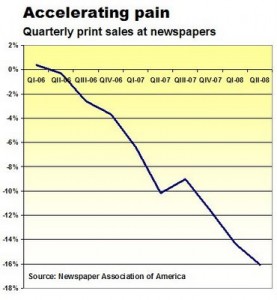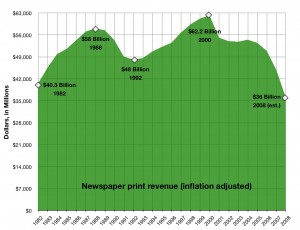It’s the dog days of summer, so even unsurprising research is good enough to draw lots of attention. This time the subject is a new Pew Research study that finds – “ surprise! – that newspapers are getting smaller, more local and more focused.
The New York Times chooses to focus on the obvious in its coverage. – “Almost two-thirds of American newspapers publish less foreign news than they did just three years ago, nearly as many print less national news, and despite new demands on newsrooms like blogs and video, most of them have smaller news staffs,” reads its lead.
We were actually more intrigued by Editor & Publisher‘s take, which zooms in on the paradox of staff cuts: – Editors by big numbers think their papers are actually improving their coverage, even as they lament that their staffs have lost their most veteran journalists in waves of buyouts and layoffs,- reads the nut graph. E&P also pulls out other nuggets like the fact that copy editor positions are being cut more than any other and that editors feel conflicted about the move to the Web. Quoting from the research: “A plurality of editors (48%), for instance, say they are conflicted by the tradeoffs between the speed, depth and interactivity of the web and what those benefits are costing in terms of accuracy and journalistic standards.”
The study does highlight the angst that’s being caused by an epic platform shift and the departure of many veteran journalists. The good news is that more than half the editors say the quality of their product has improved over the last three years. The unsettling news: – Only 5% of those responding to the survey said they were very confident of their ability to predict what their newsrooms would look like five years from now.-
Perhaps the gloom that pervades the industry is misplaced.
Media Mark Research & Intelligence (MRI) reports that total readship is up in the top 100 markets. A survey commisioned by the Newspaper National Network (NNN) found a 2.1% increase in audience size to 80.6 million between spring 2007 and spring 2008. However, media outlets were somewhat ambiguous in their interpretation of the results. Editor & Publisher interprets the data as indicating that print readership is up
while MediaPost
refers to unduplicated audience, which includes online readers. Both outlets cite newspapers’ recent clampdowns on free bonus circ as improving audience quality.If the research (which isn’t mentioned on either sponsor’s site, as far as we could tell) is about online audience, then the results aren’t that encouraging. Most newspapers have been reporting increases of 10% or more in online audience, which about mirrors the growth of the Internet overall. If the numbers refer to print readership, then they are indeed surprising, given that the Audit Bureau of Control has reported a steady downward trend in that area. Perhaps more details will emerge when the NNN actually says something about the research.
Layoff Log
The Atlanta Journal-Constitution is spending $30 million on new printing presses and cutting its staff by 8%. The loss of 189 jobs includes 85 newsroom employees and 104 people in the advertising group. The paper is also discontinuing all its regional editions, including the Gwinnett County regional, where its main printing press is located. In an open letter, the publisher explains that the AJC drives 80,000 miles a day to deliver its product and that spiraling fuel costs have hit hard. The paper has also had to absorb a 35% increase in the cost of newsprint.
In light of all those factors, the decision to invest so heavily in new presses seems a bit bizarre. We’re sure there are good business reasons, but if all the growth is online, why invest in a print product that already has a near-monopoly position in its market? We suspect there are nearly 200 soon-to-be-ex-employees of the AJC who are asking the same thing right now.
More than 3,500 newspaper jobs have vanished this summer, according to Media Post. You’ve read about most of them here, but the media publisher’s roll-up demonstrates how widespread and entrenched the industry’s problems are.
An already tense labor-management standoff at the Honolulu Advertiser wasn’t helped by last week’s announcement that the paper must cut 54 positions, or about 10% of its workforce, for the same reasons everybody else is laying off. It took all of one day for the union to authorize a strike. Workers said they had no idea the layoffs were coming and that the Advertiser claims to be profitable.
Being profitable, of course, is not a guarantee against layoffs, especially when parent Gannett Corp. just announced a 36% drop in earnings. Advertiser management is actually pressing the issue by proposing that the union be abolished so that it can have the flexibility assign reporters to take photos, for example. The union says no. In an age when competitive websites leverage content contributed by local citizens for little or no money, it makes sense to send both a reporter and a photographer to cover a story at union scale. This is a business model that the Advertiser can ride comfortably into oblivion.
The Gleaner of Henderson, KY, will eliminate nine pressroom positions and four other unspecified jobs as it moves printing to the Evansville Courier & Press. The item didn’t say how many people work at the paper.
Miscellany
The owner of Pacific Coast Business Times, a weekly business journal in Southern California, says business is great. The closure of business sections in some big dailies has helped, says Henry Dubroff. Business weeklies have lower costs and just as much credibility as the dailies they’re challenging he says. If you read between the lines of this piece, though, you’ll also see that business weeklies are more attuned to playing nicely with the businesses they cover: – The culture of a business journal is more like a small business than a traditional newspaper,” Dubroff says. “Other departments are close at hand, not on another floor. A mix of high standards and cooperation are keys to success.- Translation: business journals are more likely to write nicely about the companies they cover.
The editor and publisher of American Thinker, Thomas Lifson, writes somewhat mockingly about the decline of The New York Times under publisher Pinch Sulzberger. Repeatedly referring to the publisher by his preppy nickname, Lifson ticks off a list of questionable business judgments at the Old Gray Lady, including the decision to increase the dividend while the stock was tanking and the Ochs/Sulzberger family’s refusal to consider selling the operation. Noting Rupert Murdoch’s designs on the Times, Lifson references recent reports that Murdoch and Daily News publisher Mortimer Zuckerman are discussing ways to combine some operations in order to reduce costs. – With the financial muscle to cut prices and steal advertisers away from the Times national and metropolitan editions, Murdoch can force the Times to cut its own prices for the advertisers and readers who remain with it, further pressuring circulation revenue and readership,- he says. In other words, a death spiral.
The Asheville, NC Citizen-Times has started making reporters punch a time clock. Actually, it’s a thumbprint reader, and you have to punch in and out even if you’re going down the block to the bank. With that kind of management penny-pinching, it’s unlikely that C-T reporters are going to be burning the midnight oil on a big story any time soon.
And Finally…
Conspiracy theory? Tell Zell reveals internal communications from Tribune Co.’s IT organization telling how computer systems are being centralized at the company, making it possible for a reporter at the Baltimore Sun, for example, to file a story directly to the LA Times. Previously, the systems couldn’t talk to each other. Does this mean it will soon be possible for the Tribune papers to pool resources and send, say, four reporters to witness the same Presidential press conference instead of eight? If so, then we take back the mean things we’ve been saying about Sam Zell. Maybe the guy really does have a vision.
 The chart (from Alan Mutter) says it all. The U.S. newspaper industry experienced its ninth consecutive quarter of falling print revenue, according to the Newspaper Association of America. Worse is that the rate of decline is accelerating and online revenue is now dropping, too. Although the second quarter decline was only 2.4%, it’s a stark contrast to the 20%+ growth rates the rest of the industry is experiencing.
The chart (from Alan Mutter) says it all. The U.S. newspaper industry experienced its ninth consecutive quarter of falling print revenue, according to the Newspaper Association of America. Worse is that the rate of decline is accelerating and online revenue is now dropping, too. Although the second quarter decline was only 2.4%, it’s a stark contrast to the 20%+ growth rates the rest of the industry is experiencing.




